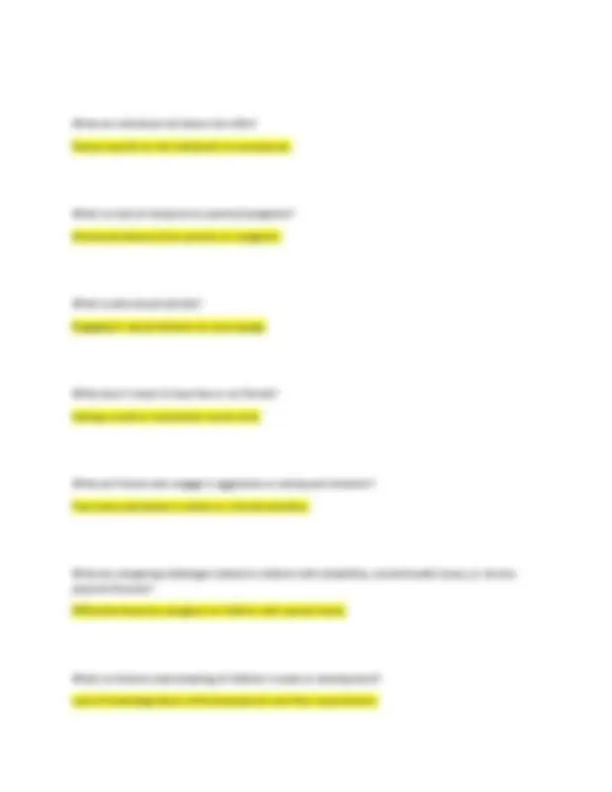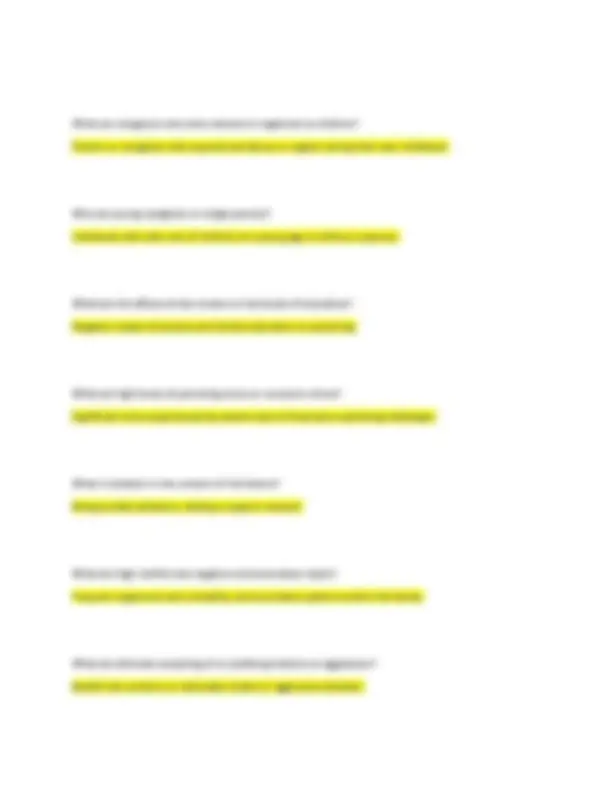
























Study with the several resources on Docsity

Earn points by helping other students or get them with a premium plan


Prepare for your exams
Study with the several resources on Docsity

Earn points to download
Earn points by helping other students or get them with a premium plan
Community
Ask the community for help and clear up your study doubts
Discover the best universities in your country according to Docsity users
Free resources
Download our free guides on studying techniques, anxiety management strategies, and thesis advice from Docsity tutors
NR606 Week 7 Exam (Latest Update) Questions and Verified Answer Elaborations (100% Correct)
Typology: Assignments
1 / 30

This page cannot be seen from the preview
Don't miss anything!























What did the CDC and Kaiser Permanente investigate? Childhood abuse, neglect, and stressful events What did the study find? Strong relationship between ACEs and health risk behaviors and disease in adulthood What did later studies find? ACEs increase likelihood of adversity, chronic illness, and early death What are some examples of later studies? Boppre & Boyer (2021), LaNoue et al. (2020), Lee et al. (2020), Struck et al. (2021) What are some examples of ACEs? Sexual or domestic violence, abuse, neglect, unsafe home environment. How do ACEs affect the developing brain? They adversely affect brain structure and functioning.
What factors impact a child's response to trauma? Frequency, seriousness, type of traumatic event, prior trauma history, and availability of support. How common are ACEs in adults? One in six adults have experienced four or more ACEs. What are the leading causes of death related to ACEs? Five or more of the top 10 leading causes of death. Who is at greater risk of experiencing four or more ACEs? Females and racial/ethnic minority groups. What is the ACE Pyramid? Conceptual framework for studying ACEs. What did the ACE study reveal? ACEs are strongly related to risk factors for poor health and social consequences. What did the ACE study identify? Risk factors for ACEs and informed prevention programs. What does the ACE Pyramid represent?
What are individual risk factors for ACEs? Factors specific to the individual's circumstances. What is a lack of closeness to parents/caregivers? Emotional distance from parents or caregivers. What is early sexual activity? Engaging in sexual behavior at a young age. What does it mean to have few or no friends? Having a small or nonexistent social circle. What are friends who engage in aggressive or delinquent behavior? Peers who participate in violent or criminal activities. What are caregiving challenges related to children with disabilities, mental health issues, or chronic physical illnesses? Difficulties faced by caregivers of children with special needs. What is a limited understanding of children's needs or development? Lack of knowledge about child development and their requirements.
What are caregivers who were abused or neglected as children? Parents or caregivers who experienced abuse or neglect during their own childhood. Who are young caregivers or single parents? Individuals who take care of children at a young age or without a partner. What are the effects of low income or low levels of education? Negative impact of poverty and limited education on parenting. What are high levels of parenting stress or economic stress? Significant stress experienced by parents due to financial or parenting challenges. What is isolation in the context of risk factors? Being socially isolated or lacking a support network. What are high conflict and negative communication styles? Frequent arguments and unhealthy communication patterns within the family. What are attitudes accepting of or justifying violence or aggression? Beliefs that condone or rationalize violent or aggressive behavior.
What is intimate partner violence? Abuse or violence within a romantic or domestic relationship. What is physical abuse? Parent or caregiver causing physical injury to a child. What percentage of child maltreatment cases involve physical abuse? Approximately 10%. What are some effects of physical abuse on children? Struggle with self-esteem, social relationships, trust, stress reactions. What is sexual abuse? Any interaction where a child is used for sexual gratification. What percentage of child maltreatment cases involve sexual abuse? Approximately 7%. What are some long-term consequences of sexual abuse? Increased risk for substance abuse, risky sexual behaviors, self-harm, PTSD, depression, and anxiety.
What is child neglect? Failure to provide for a child's needs. What percentage of child maltreatment cases involve neglect? Approximately 60%. What are some age-appropriate needs that can be neglected? Food, shelter, clothing, education, medical care, supervision, and emotional needs. What can neglect result in? Long-lasting physical or psychological harm. What is neglect often tied to? Poverty. What are some signs of neglect in children? Poor hygiene, inadequate weight gain, inappropriate clothing. What is household instability? Contributing factor to adverse childhood experiences (ACEs). What can cause family instability?
How does community violence affect children? Can have negative effects on their well-being and development. What are some examples of community violence? Gang violence, shootings, or domestic violence. How can cultural challenges impact children? Can affect their sense of identity, belonging, and well-being. What are some examples of cultural challenges? Language barriers, discrimination, or conflicting cultural values. What is community violence? Exposure to interpersonal violence in public settings Give examples of community violence. Shootings, fights, bullying, war, terrorist attacks What is bullying? Aggression or harassment causing harm to someone perceived as less powerful
What are the types of bullying? Physical, verbal, social, cyberbullying What is cyberbullying? Bullying that occurs through electronic means What are the effects of bullying? Stress, trauma, anger, isolation, poor self-esteem, school issues, health problems, self-injury, eating disorders, suicidal or homicidal thoughts What are the effects of community violence? Heightened fear and stress What is peer victimization? Another term for bullying What is the definition of racism? Discrimination based on race What is structural racism? Systemic discrimination embedded in institutions and policies
What are the lasting health consequences of childhood adversity perpetuated by racism? Health disparities. Give examples of ACEs that place a child in immediate physical danger. Traumatic brain injury, fractures, burns. What are some mental health consequences of ACEs? Depression, anxiety, PTSD. How can ACEs impact maternal health? Unintended pregnancy, pregnancy complications, fetal death. What infectious diseases can be impacted by ACEs? HIV, STDs. What are some physical health consequences of ACEs? Cancer, diabetes. What risky health behaviors can be influenced by ACEs? Alcohol and drug abuse, unsafe sex. What are some autoimmune disorders that can be increased by ACEs?
Arthritis. What is the relationship between ACEs and type 2 diabetes? Increased risk. What are some mental illnesses that can be influenced by ACEs? Depression, anxiety, PTSD. What are some risky behaviors associated with ACEs? Substance use disorder, suicide, unemployment. What are the potential impacts of ACEs on education, occupation, and income? Opportunity disparities. How does the wounded child adapt? Develops protective behaviors that hinder healthy relationships. What is the wounded child? A young, vulnerable child wounded by abuse or neglect. What are some characteristics of the wounded child? Overwhelmed, longing for connection, focus of trauma work.
How is the functional adult different from the child parts? Adaptable and capable of learning and using new skills. According to Terry Real, who creates problems in a client's relationships? The adaptive child. What do interventions need to focus on? The adaptive child to engage the functional adult. What is the ACE questionnaire? Assessment of childhood adversity exposure. What does a high ACE score indicate? High exposure to adversity in childhood. Does a high ACE score guarantee negative outcomes? No, it does not guarantee negative outcomes. What can providers do to support children with high ACE scores? Teach stress-reduction techniques and positive coping skills.
How can parent training help caregivers? Learn healthy ways to manage child behaviors. What can early childhood programs provide? Protective factors for positive development in young children. What is resilience? Ability to adapt and recover from adversity. What are some factors that promote resilience? Close relationships, positive parenting, sense of purpose, individual competencies, social connections, support services, community support. What does trauma-informed care mean? Approach that recognizes and responds to the impact of trauma. What are the six guiding principles of trauma-informed care? Understanding trauma's impact, determining treatment plan, avoiding retraumatization. Why is trauma-informed care important? To effectively care for clients who have experienced adversity.
Access to support services for parents and families, community support resources. What is safety in trauma-informed care? Creating physical and psychological safety to avoid retraumatization. Why is trust and transparency important in trauma-informed care? Establishing a therapeutic alliance and empowering intake procedures. How does peer support contribute to trauma-informed care? Fosters safety, hope, and healing through shared experiences. What is the role of collaboration in trauma-informed care? Empowering clients to be active in treatment decisions. How does empowerment and choice impact trauma-informed care? Gives clients a sense of control and promotes self-efficacy. Why is cultural, historical, and gender awareness important in trauma-informed care? Acknowledges trauma related to culture, history, or gender identity. What are some psychological distress symptoms after a traumatic event? Anxiety, fear, anhedonia, anger, aggression, dissociative symptoms
What are some long-term reactions to traumatic events? Depression, anxiety, behavioral changes, academic difficulties When do symptoms often present in children? When reminded of the traumatic event What manual provides diagnostic criteria for disorders associated with traumatic events? DSM- 5 - TR What percentage of adolescents experience PTSD each year? Approximately 5% What are some factors that increase the risk of developing PTSD? Prior trauma, adverse childhood experiences, personal or family history of psychiatric disorders, female gender, severe trauma exposure What are some consequences of PTSD? Social, occupational, and physical impairment, physical health problems, reduced quality of life, increased risk of suicide What are some common comorbidities with PTSD?